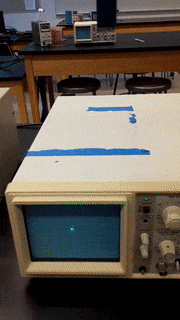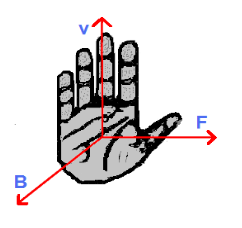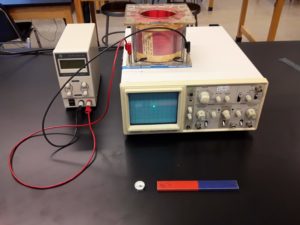Magnetic Force
Tasks
- Use a compass to draw the magnetic field of a bar magnet and an electromagnet.
- Study how moving electrons are deflected by the field of the magnets and compare to your predictions.
Resources
- Oscilloscope (cathode ray tube style)
- Bar magnet
- Solenoid
- Power Supply
- Compass
Background
Magnetic fields exert force on charges similarly to electric fields, but only if the charge is moving relative to the field. The strength of the force a magnetic field B (usually measured in Teslas) exerts on a charge q moving with velocity v is F=qvB\sin\theta where \theta is the angle between the field and the charge’s direction of motion. Note that this means the magnetic force is zero if the charge is moving parallel to the field!
 The direction of the magnetic force is given by the following right-hand rule: point the fingertips in the direction of the charge’s velocity, then curl the fingers in the direction of the magnetic field. The thumb then points in the direction of the magnetic force, which is perpendicular to the velocity and field vectors. If the charged particles are negative (i.e. electrons), the formula above gives a negative result and the force points in the opposite direction.
The direction of the magnetic force is given by the following right-hand rule: point the fingertips in the direction of the charge’s velocity, then curl the fingers in the direction of the magnetic field. The thumb then points in the direction of the magnetic force, which is perpendicular to the velocity and field vectors. If the charged particles are negative (i.e. electrons), the formula above gives a negative result and the force points in the opposite direction.
Older oscilloscopes (and televisions) use a cathode-ray tube to produce images. Electrons are shot from the back of the device toward the screen, where they produce a glowing dot when they interact with the material of the screen. An oscilloscope moves this beam around to literally draw images on the screen, but it can also be used as a ready source of fast-moving electrons that can be manipulated with the field of a magnet.
